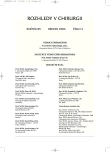Postoperative Re-stenosis of the Carotid – A Case for Reoperation or Endovascular Management?
Pooperační restenóza karotidy – reoperace nebo endovaskulární řešení?
Cílem naší práce bylo zjistit, jak časté je následné opakování restenózy po operačním nebo endovaskulárním řešení restenóz po primárních endarterektomiích a. carotis s ohledem na přidružené choroby a druhostranný nález, a zda je rozdílný počet peroperačních a pooperačních komplikací. Do retrospektivní studie jsme zařadili pacienty operované během sedmiletého období na jediném cévně chirurgickém pracovišti. Zjistili jsme, že opakovaná restenóza byla statisticky významně (3×) častější při endovaskulárním řešení než při reoperaci (p = 0,015). U pacientů s opakující se restenózou bylo statisticky významně častější postižení kontralaterální karotidy (93,8 %, p = 0,05) a také uzávěr druhostranné tepny (43,8 %, p = 0,05). Nejvyšší výskyt opakující se restenózy karotidy je u pacientů s postižením druhostranné tepny. Chirurgické řešení opakující se restenózy a. carotis po primární operaci má lepší výsledky než endovaskulární výkon.
Klíčová slova:
restenóza – a. carotis – endarterektomie – endovaskulární – PTA
Authors:
P. Šedivý; P. Šebesta; T. Klika; P. Zdráhal; P. Štádler; P. Czinner; K. Weiss
Authors‘ workplace:
Oddělení cévní chirurgie, Nemocnice na Homolce, Praha, primář doc. MUDr. P. Šebesta, CSc.
Published in:
Rozhl. Chir., 2006, roč. 85, č. 3, s. 118-123.
Category:
Monothematic special - Original
Overview
The aim of this work was to assess frequency rates of re-stenoses following surgical or endovasular treatment of re-stenoses after primary endarterectomies of the carotid artery, taking into consideration concomitant disorders and the contralateral findings. Another objective was to assess differences in peroperative and postoperative complications frequency rates. The retrospective study included patients undergoing vascular surgery during a seven-year period. The study revealed that repetitive restenoses were statistically significantly (3×) more frequent in cases of the endovascular management compared to that in re-operations (p = 0.015). In the repetitive re-stenoses patients, the rate of the contralateral carotid affection was significantly higher (93.8%, p = 0.05) and also the rate of the contralateral artery obliteration was higher (43.8%, p = 0.05). The highest frequency rates of the repetitive carotid re-stenosis was in patients with a concomitant affection of the contralateral artery. Surgical management of the repetitive re-stenosis of the carotid artery following its primary surgical management showed better results than the endovascular management.
Key words:
re-stenosis – a. carotis – endarterectomy – endovascular – PTA
Labels
Surgery Orthopaedics Trauma surgeryArticle was published in
Perspectives in Surgery

2006 Issue 3
- Metamizole vs. Tramadol in Postoperative Analgesia
- Metamizole in perioperative treatment in children under 14 years – results of a questionnaire survey from practice
- Possibilities of Using Metamizole in the Treatment of Acute Primary Headaches
- Metamizole at a Glance and in Practice – Effective Non-Opioid Analgesic for All Ages
Most read in this issue
- Surgical Management of Major Scrotal Hernias
- Postoperative Adhesions, the Everlasting Topical Subject
- Rare Compartment Syndromes of the Peripheral Nerves of the Forearm and Distal Leg
- Postoperative Re-stenosis of the Carotid – A Case for Reoperation or Endovascular Management?
